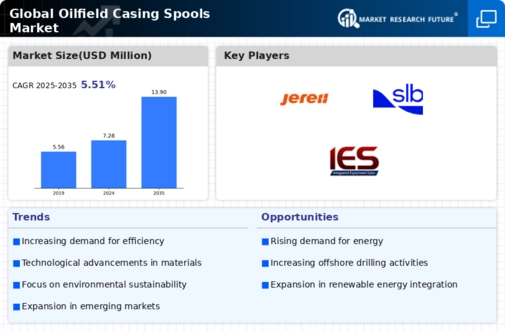Market Share
Oilfield Casing Spools Market Share Analysis
The oilfield casing spools market has been influenced by several key trends, reflecting the dynamic nature of the oil and gas industry. Casing spools play a crucial role in oilfield operations, providing support and sealing for wellheads and casing strings. One notable trend in this market is the increasing demand for more technologically advanced and durable casing spools. Oil and gas exploration and production activities are expanding into more challenging environments, such as deepwater and high-pressure/high-temperature (HP/HT) reservoirs. This has led to the need for casing spools capable of withstanding extreme conditions while ensuring reliable wellhead integrity and safety.
Moreover, there's a growing emphasis on cost-effective and time-efficient solutions within the oilfield casing spools market. Companies operating in the oil and gas sector are increasingly focused on optimizing operational efficiencies and reducing downtime. As a result, there's a trend towards the development of casing spools that streamline installation processes, minimize maintenance requirements, and offer easier access for well interventions. Manufacturers are innovating to design casing spools that facilitate quicker installation and allow for swift adjustments and replacements when needed, ultimately reducing operational costs and improving overall efficiency.
Additionally, the market is witnessing advancements in materials and manufacturing techniques for casing spools. There's a shift towards utilizing high-grade materials, such as corrosion-resistant alloys and advanced composites, to enhance the durability and longevity of casing spools, especially in harsh operating conditions. Furthermore, the adoption of advanced manufacturing processes, including 3D printing and precision machining, is enabling the production of casing spools with intricate designs and precise tolerances, ensuring superior performance and reliability.
Furthermore, the growing focus on environmental sustainability and regulatory compliance is influencing the oilfield casing spools market. There's an increased scrutiny on minimizing environmental impact throughout the entire oil and gas extraction process. As a result, there's a trend towards developing casing spools that adhere to stringent environmental standards, including leak prevention and emission control measures. Manufacturers are designing spools with improved sealing technologies to prevent leaks and reduce the risk of environmental contamination, aligning with industry regulations and environmental conservation efforts.
Moreover, technological advancements, such as digitalization and IoT integration, are starting to make inroads into the oilfield casing spools market. Companies are exploring the incorporation of sensors and monitoring systems into casing spools to enable real-time data collection and remote monitoring of wellhead conditions. This trend towards smart casing spools allows for proactive maintenance, early detection of potential issues, and better decision-making, contributing to enhanced operational efficiency and safety.
The oilfield casing spools market is evolving in response to various factors, including technological advancements, operational efficiency demands, environmental considerations, and regulatory requirements. The focus on designing robust, cost-effective, and environmentally friendly casing spools capable of withstanding challenging operating conditions continues to drive innovation within the industry. As oil and gas exploration ventures into more complex terrains, the market for advanced and reliable casing spools is expected to witness continued growth and development in the foreseeable future.






Leave a Comment